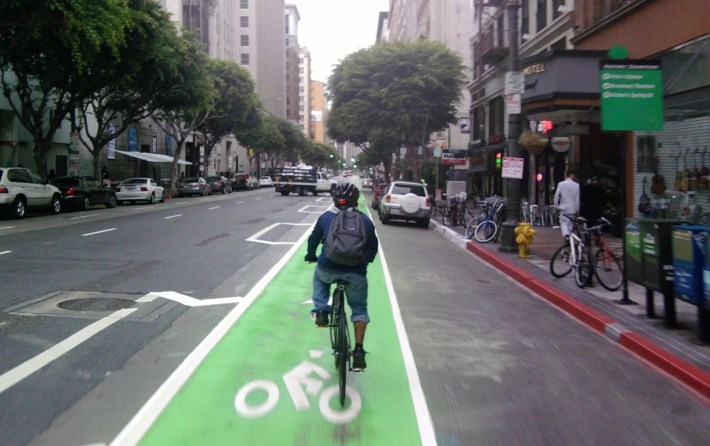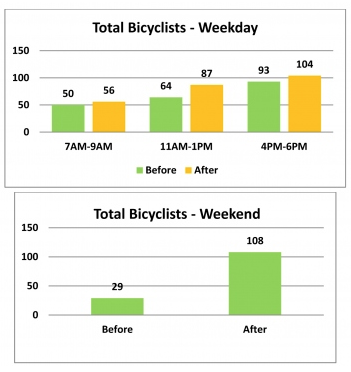
Yesterday, the Los Angeles County Bicycle Coalition released "2011 City of Los Angeles Bicycle & Pedestrian Count Report" and a separate study on bicycling on Spring Street in the Green Buffered Bike Lane. The result? Cycling in the city is on the upswing, as positive press, CicLAvia and new infrastructure are encouraging more people to embrace two-wheeled travel.

Nowhere is this more true than Spring Street. Bike counts taken before and after the creation of the city's first green lane and first buffered bike lane, show a 52% increase in cyclists on Spring Street. This included a mammoth 250% increase in cyclists on weekends and a 161% increase in female riders.
LACBC conducted baseline counts on Tuesday, November 1st and Saturday, November 5th. The Tuesday counts were conducted from 7:00 A.M. to 9:00 A.M., 11:00 A.M. to 1:00 P.M., and 4:00 to 6:00 P.M. The Saturday count was conducted from 11:00 A.M. to 1:00 P.M. The after counts were conducted on Tuesday, April 24th and Saturday, May 28th at the same times as the before counts.
"So glad to see people who bike in Downtown L.A. embracing the new lane," exclaims Valerie Watson, the Chair of the Downtown Neighborhood Council's Parks, Recreation and Open Space Committee. "(we're) thankful to LACBC for offering this invaluable data that allows us to see these trends and apply this knowledge to future Downtown Bike Network planning."
The survey brought mixed results on the impact of the lane on sidewalk riding. The number of bicyclists who used the sidewalk declined 10% after the bike lane was painted but rose 117% during the weekend.
"Issues with sidewalk and wrong-way riding remain, and are a constant complaint from residents and business owners DTLA," explains Watson. "But with the coming installation of the Main Street buffered bike lane from 9th to Cesar Chavez, completing the north/south couplet with Spring, we hope to see a decrease in this kind of behavior that typifies an incomplete network."
In short, Watson argues that readers shouldn't judge the impact of new bike infrastructure on sidewalk riding until after there are more connecting buffered lanes. Cyclists uncomfortable mixing with traffic are unlikely to merge on and off the sidewalk, even when the green lane is present.
From their city-wide study, the LACBC sees a connection between bike infrastructure and bike ridership. As the city paints new bike lanes and Sharrows in the first year of the implementation of the new Bike Plan, volunteers counted a 32% increase in cyclists over previous years in the count locations. Despite the sharp increase of female riders on Spring Street, the LACBC study did not find an increase in women cyclists city-wide. Roughly one in every five cyclists counted were women. This evidence supports national research showing that separated bicycle infrastructure has greater success encouraging new female riders than traditional infrastructure.
Of course, all of this evidence is just a snapshot of bicycling in Los Angeles. LACBC encourages the city to be more proactive in doing its own bike counts year round instead of relying on data gathered whenever LACBC can muster the volunteers. In addition to encouraging the city to increase the investment in bike lanes, bike paths and separated or buffered infrastructure, the Bike Coalition also wants the city to invest more time and funding in bicycle and pedestrian counts to track the impact of road changes and inform transportation planning decisions.
You can read LACBC's blog for more on the report, or just read the report itself here.






